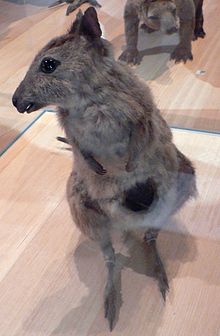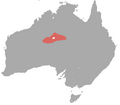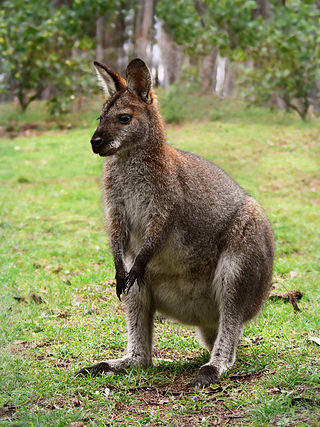
A wallaby is a small or middle-sized macropod native to Australia and New Guinea, with introduced populations in New Zealand, Hawaii, the United Kingdom and other countries. They belong to the same taxonomic family as kangaroos and sometimes the same genus, but kangaroos are specifically categorised into the four largest species of the family. The term "wallaby" is an informal designation generally used for any macropod that is smaller than a kangaroo or a wallaroo that has not been designated otherwise.

Diprotodontia is the largest extant order of marsupials, with about 155 species, including the kangaroos, wallabies, possums, koala, wombats, and many others. Extinct diprotodonts include the hippopotamus-sized Diprotodon, and Thylacoleo, the so-called "marsupial lion".
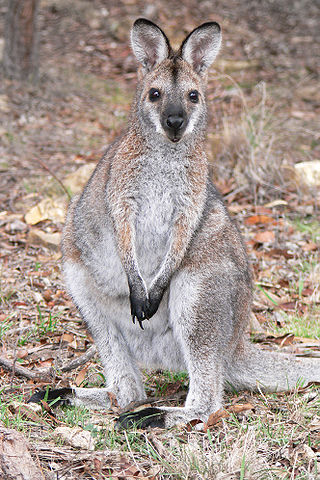
Macropodidae is a family of marsupials that includes kangaroos, wallabies, tree-kangaroos, wallaroos, pademelons, quokkas, and several other groups. These genera are allied to the suborder Macropodiformes, containing other macropods, and are native to the Australian continent, New Guinea and nearby islands.

The banded hare-wallaby, mernine, or munning is a marsupial currently found on the islands of Bernier and Dorre off western Australia. Reintroduced populations have recently been established on islands and fenced mainland sites, including Faure Island and Wadderin Sanctuary near Narembeen in the central wheatbelt.

The bridled nail-tail wallaby, also known as the bridled nail-tailed wallaby, bridled nailtail wallaby, bridled wallaby, merrin, and flashjack, is a vulnerable species of macropod. It is a small wallaby found in three isolated areas in Queensland, Australia, and whose population is declining. In early 2019 the total population of the species was estimated to be fewer than 500 mature individuals in the wild and 2285 in captivity.

The eastern hare-wallaby, once also known as the common hare wallaby, is an extinct species of wallaby that was native to southeastern Australia. It was first described by John Gould in 1841.

Threatened fauna of Australia are those species and subspecies of birds, fish, frogs, insects, mammals, molluscs, crustaceans, and reptiles to be found in Australia that are in danger of becoming extinct. This article lists species classified as threatened species under the Commonwealth Environment Protection and Biodiversity Conservation Act 1999.
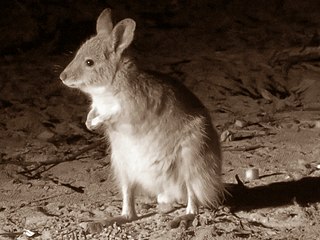
The rufous hare-wallaby, also known as the mala, is a small macropod found in Australia. It was formerly widely distributed across the western half of the continent, but naturally occurring populations are now confined to Bernier Island and Dorre Island Islands off Western Australia.

The spectacled hare-wallaby is a species of macropod found in Australia and New Guinea. In Australia, a small sub-population is found on Barrow Island, while the mainland type is widespread, though in decline, across northern regions of the country.
The Lake Mackay hare-wallaby, also known as the central hare-wallaby or kuluwarri, is an extinct species of macropod formerly found in central Australia. Very little is known about it.
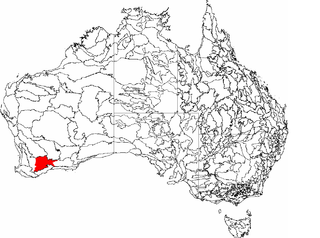
Western Mallee is an Interim Biogeographic Regionalisation for Australia (IBRA) subregion in southern Western Australia. It is a sparsely populated subregion with an area of about 47,000 square kilometres, roughly centred on the town of Newdegate. Largely cleared for intensive agriculture, it still retains patches of native vegetation, but these are under environmental stress from threats such as rising salinity, and are poorly managed.
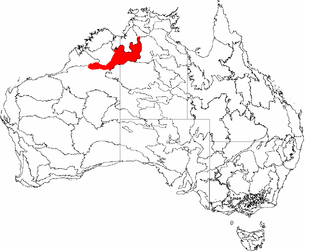
The Ord Victoria Plain, an interim Australian bioregion, is located in the Northern Territory and Western Australia, comprising 12,540,703 hectares.

Yalgoo is an interim Australian bioregion located in Western Australia. It has an area of 5,087,577 hectares. The bioregion, together with the Avon Wheatbelt and Geraldton Sandplains bioregions, is part of the larger Southwest Australia savanna ecoregion as classified by the World Wildlife Fund.
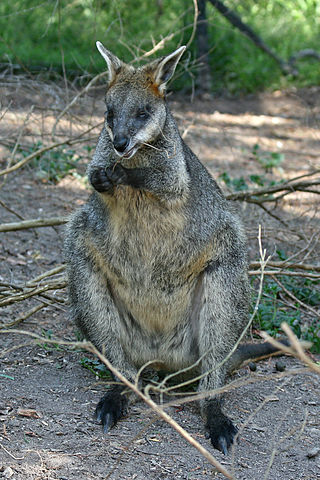
Macropodinae is a subfamily of marsupials in the family Macropodidae, which includes the kangaroos, wallabies, and related species. The subfamily includes about ten genera and at least 51 species. It includes all living members of the Macropodidae except for the banded hare-wallaby, the only surviving member of the subfamily Lagostrophinae.

Klossiella is a genus of parasitic alveolates of the phylum Apicomplexa. Species in this genus infect the renal tract of mammals and intestinal tract of snakes.
Wadderin Sanctuary is a nature conservation project within the Shire of Narembeen in the eastern wheatbelt of Western Australia. It is about 290 kilometres (180 mi) east of Perth and 8 kilometres (5.0 mi) north of the town of Narembeen. Wadderin is surrounded by a fox- and cat-proof fence that was completed in early 2008. This has allowed the reintroduction of fauna that is uncommon or locally extinct in the wheatbelt, and includes species that are considered threatened at the national level.
